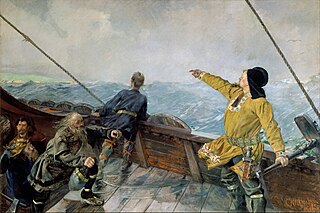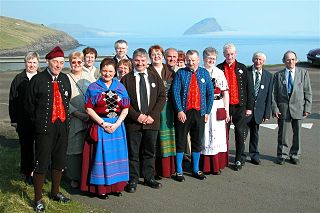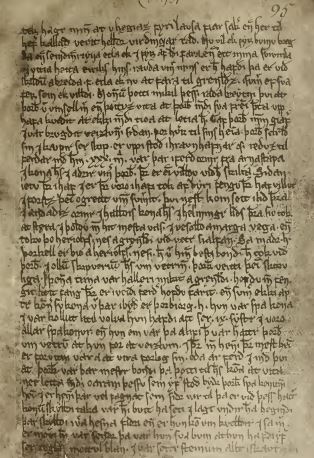| |||||
| Decades: | |||||
|---|---|---|---|---|---|
| See also: | Other events in 1820 · Timeline of Icelandic history | ||||
Events in the year 1820 in Iceland .
| |||||
| Decades: | |||||
|---|---|---|---|---|---|
| See also: | Other events in 1820 · Timeline of Icelandic history | ||||
Events in the year 1820 in Iceland .

Sagas are prose stories and histories, composed in Iceland and to a lesser extent elsewhere in Scandinavia.

Flateyjarbók is an important medieval Icelandic manuscript. It is also known as GkS 1005 fol. and by the Latin name Codex Flateyensis. It was commissioned by Jón Hákonarson and produced by the priests and scribes Jón Þórðarson and Magnús Þórhallsson.

Faroese people or Faroe Islanders are an ethnic group native to the Faroe Islands. The Faroese are of mixed Norse and Gaelic origins. About 21,000 Faroese live in neighbouring countries, particularly in Denmark, Iceland and Norway. Most Faroese are citizens of the Kingdom of Denmark, in which the Faroe Islands are a constituent nation. The Faroese language is one of the North Germanic languages and is closely related to Icelandic and to western Norwegian varieties.

Hauksbók is a 14th century Icelandic manuscript created by Haukr Erlendsson. Significant portions of it are lost, but it contains the earliest copies of many of the texts it contains, including the Saga of Eric the Red. In most cases, Haukr copied from earlier, now lost manuscripts. Among these are the section on mathematics called Algorismus, the text of Hervarar saga ok Heiðreks. It was originally in one part, but now split in three and held at the Árni Magnússon Institute for Icelandic Studies in Reykjavík, Iceland.

Möðruvallabók or AM 132 fol is an Icelandic manuscript from the mid-14th century, inscribed on vellum. It contains the following Icelandic sagas in this order:
Icelandic literature refers to literature written in Iceland or by Icelandic people. It is best known for the sagas written in medieval times, starting in the 13th century. As Icelandic and Old Norse are almost the same, and because Icelandic works constitute most of Old Norse literature, Old Norse literature is often wrongly considered a subset of Icelandic literature. However, works by Norwegians are present in the standard reader Sýnisbók íslenzkra bókmennta til miðrar átjándu aldar, compiled by Sigurður Nordal on the grounds that the language was the same.

Grímur Thomsen, Icelandic poet and editor, was born in Bessastaðir in 1820. He was the son of Þorgrímur Tómasson, a goldsmith. In 1837, he went to the University of Copenhagen, where he studied law and philology, but he also became interested in philosophy and aesthetics. He became an enthusiastic follower of the Pan-Scandinavian movement, although this was not generally favored by his countrymen.

The Árni Magnússon Institute for Icelandic Studies is an institute of the Ministry of Education, Science and Culture of Iceland which conducts research in Icelandic and related academic studies, in particular the Icelandic language and Icelandic literature, to disseminate knowledge in those areas, and to protect and develop the collections that it possesses or those placed in its care. It is named after Árni Magnússon, a 17th–18th century collector of medieval Icelandic manuscripts.
Bandamanna saga is one of the sagas of Icelanders. It is the only saga in this category that takes place exclusively after the adoption of Christianity in the year 1000.
Finnboga saga ramma is an Icelandic saga that recounts the life of Finnbogi rammi. The story takes place in Flateyjardalur in Suður-Þingeyjarsýsla and in other places in Iceland, as well as in Norway. The events supposedly took place in the 10th century. Finnbogi rammi is mentioned in Landnámabók, and Íslendingadrápa.
Gunnars saga Keldugnúpsfífls is one of the sagas of Icelanders. It is a late saga composed in the 15th or 16th century. It survives in 17th-century manuscripts.
Vatnsdæla saga is one of the sagas of Icelanders. The saga follows several generations of a family originating in Norway and settling in the north of Iceland until the arrival of Christianity in the late tenth century.
Ölkofra þáttr, the "Tale of Ölkofri" or the "Tale of Ale-Hood", is a þáttr, a minor Old Norse prose genre related to the sagas of Icelanders. Preserved in the 14th-century manuscript known as Möðruvallabók and other post-Reformation copies, the tale is a satire on the judicial system of the medieval Icelandic Commonwealth. It tells the story of an ale-brewer, named Þórhallr but known as Ölkofri or "Ale-Hood" for the hood that he habitually wears. Ölkofri accidentally sets fire to some valuable woodland belonging to six powerful Icelandic chieftains. These chieftains consequently file suit against him at the Althing in an effort to get him outlawed, but thanks to the efforts of men who unexpectedly come to his aid, Ölkofri manages to escape this fate.
Sigrgarðs saga frœkna is a medieval Icelandic romance-saga, described by Finnur Jónsson as 'all in all ... one of the best and most worthy of reading' of the Icelandic 'stepmother-sagas'.
Eggertsbók is a fragmentary Icelandic manuscript, produced in the last quarter of the fifteenth century; its provenance is currently unknown. The manuscript now survives bound in two separate parts, now known as 'a' and 'b'. However, it is likely that originally the 'b' section came first.
Grímur is a Faroese and Icelandic masculine given name. People bearing the name Grímur include:

Sigvaldi Kaldalóns (Stefánsson) was an Icelandic composer and doctor. Unlike the avant-garde composers of his day, he wrote in a traditional romantic style and composed many of Iceland's most famous and widely performed songs, many of which are now wrongly assumed to be folk songs. His particular skill was in capturing the spirit of poems in his melodies, making him Iceland's foremost lyric composer. Since the end of 2016, his works have entered the public domain in Iceland.
Codex Scardensis or Skarðsbók postulasagna is a large Icelandic manuscript containing Old Norse-Icelandic sagas of the apostles. It is, along with Flateyjarbók, one of the largest 14th century manuscripts produced in Iceland. The manuscript was written in c.1360 at the house of canons regular at Helgafell for Ormr Snorrason. From 1401 to 1807 it was housed at the church in Skarð. From 1827 until 1890 it was considered lost, with its printed edition being based on copies made in the 18th century. The manuscript returned to Iceland in 1965 after being purchased at Sotheby's in London by a consortium of Icelandic banks.
Alexanders saga is an Old Norse translation of Alexandreis, an epic Latin poem about the life of Alexander the Great written by Walter of Châtillon, which was itself based on Quintus Curtius Rufus's Historia Alexandri Magni. It is attributed in manuscripts of the saga to Brandr Jónsson, bishop of Skálholt who is also said to have been responsible for authoring Gyðinga saga. Kirsten Wolf has commented on the saga's literary qualities thus: "Alexanders saga [...] has stirred the admiration of scholars and writers for centuries because of its exceptionally imaginative use of the resources of language and its engaging narrative style."
Grega saga is an Old Norse chivalric saga known only from a manuscript that survives as a single leaf: AM 567 XXVI 4to. As it has no known exemplar, it is considered to be an original Old Norse composition. The saga uses motifs found in Ívens saga and Þiðreks saga: a grateful lion becomes Grega's companion and kills three giants. The leaf was written by Magnús Þórhallsson, who worked on Flateyjarbók with Jón Þórðarson.